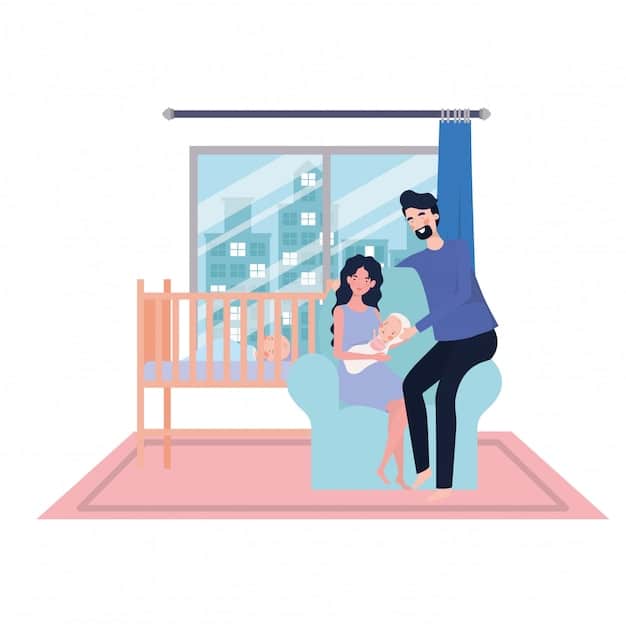The Ultimate Guide to Baby Naps: Lengthening Daytime Sleep

The Ultimate Guide to Naps: How to Get Your Baby to Sleep Longer During the Day explores the science behind infant sleep, offering practical strategies to optimize nap schedules, create restful environments, and address common sleep challenges, ensuring both baby and parents get the much-needed daytime rest.
Navigating the world of baby sleep can feel overwhelming, especially when it comes to naps. This ultimate guide to naps: how to get your baby to sleep longer during the day will provide you with the knowledge and tools you need to establish healthy sleep habits, ensuring your little one gets the restorative rest they need during the day.
The Science of Baby Sleep: Understanding Nap Needs
Understanding your baby’s sleep patterns is the first step to improving their naps. Babies have different sleep cycles and needs compared to adults. Knowing these differences can help you create a more effective sleep schedule and environment.
Sleep Cycles in Infants
Infants’ sleep cycles are shorter than adults’, typically lasting about 50-60 minutes. This means they transition between light and deep sleep more frequently, making them more susceptible to waking up.
Why Naps Are Crucial
Naps are essential for a baby’s cognitive and physical development. They help improve mood, enhance learning, and support overall health. Without adequate naps, babies can become overtired and more difficult to settle for nighttime sleep.
- Naps consolidate learning and memory.
- They prevent overstimulation and irritability.
- Naps support healthy growth and development.
- They contribute to better nighttime sleep.

Recognizing the importance of naps and understanding the science behind infant sleep can dramatically improve your baby’s daytime sleep habits. By tailoring your approach to meet your baby’s unique needs, you can set the stage for longer, more restorative naps. This understanding forms the foundation for creating a supportive environment and schedule conducive to better sleep.
Creating the Perfect Nap Environment
The environment in which your baby naps plays a significant role in the duration and quality of their sleep. A consistent and calming environment signals to your baby that it’s time to relax and sleep.
Optimal Room Conditions
Ensure the room is dark, quiet, and cool. Blackout curtains can block out light, and a white noise machine can mask distracting sounds. The ideal room temperature is between 68-72°F (20-22°C).
The Importance of Darkness
Darkness triggers the release of melatonin, a hormone that promotes sleep. A dark room helps your baby fall asleep faster and stay asleep longer. Even a small amount of light can disrupt their sleep cycle.
- Use blackout curtains to block out sunlight.
- Consider using a red night light for nighttime feeds or diaper changes.
- Ensure no electronic devices emit light in the room.
- Maintain a consistent level of darkness for all naps.
Creating a sleep-conducive environment is a crucial step in helping your baby nap longer. By addressing factors like light, noise, and temperature, you can significantly improve the quality and duration of their daytime sleep. A consistent and calming environment signals to your baby that it’s time to relax and drift off to sleep. This preparation sets the stage for more predictable and restful naps, benefiting both baby and parents.
Establishing a Consistent Nap Schedule
Consistency is key when it comes to baby sleep. A regular nap schedule helps regulate your baby’s internal clock, making it easier for them to fall asleep and stay asleep.
Age-Appropriate Wake Windows
Understanding wake windows is crucial for timing naps correctly. Wake windows are the periods your baby can comfortably stay awake without becoming overtired. These windows vary by age.
Sample Nap Schedules
Here are some general guidelines for nap schedules based on age:
- Newborns (0-3 months): Multiple short naps throughout the day, typically 1-2 hours apart.
- 4-6 months: 3-4 naps a day, totaling 3-4 hours of daytime sleep.
- 7-12 months: 2 naps a day, totaling 2-3 hours of daytime sleep.
- 12-18 months: 1 nap a day, lasting 1.5-2.5 hours.

Recognizing Sleep Cues
Pay attention to your baby’s sleep cues, such as yawning, eye-rubbing, and fussiness. These cues indicate that your baby is tired and ready for a nap. Responding promptly can prevent them from becoming overtired and more difficult to settle.
Establishing a consistent nap schedule and recognizing your baby’s sleep cues are vital for promoting longer naps. By aligning your baby’s sleep times with their natural rhythms, you can create a predictable routine that supports restful daytime sleep. This consistency helps regulate their internal clock and makes it easier for them to fall asleep and stay asleep, leading to more restorative naps and a happier baby.
The Naptime Routine: Preparing for Sleep
A consistent naptime routine signals to your baby that it’s time to sleep. This routine should be calming and predictable, helping them transition from wakefulness to sleepiness.
Steps for a Calming Routine
A simple naptime routine might include:
- Changing the diaper
- Reading a short book
- Singing a lullaby
- Swaddling (if appropriate for age)
The Role of Swaddling
Swaddling can help newborns feel secure and prevent the startle reflex from waking them up. However, it’s essential to stop swaddling once your baby shows signs of rolling over.
White Noise Benefits
White noise can mask distracting sounds and create a soothing environment for sleep. A consistent sound can help your baby stay asleep even if there are noises in the background.
Implementing a consistent naptime routine is a powerful tool for promoting longer and more restful naps. By following the same steps each time, you create a predictable and calming signal that prepares your baby for sleep. This routine helps ease the transition from wakefulness to sleepiness, making it easier for them to relax and drift off. The combination of a predictable routine, appropriate swaddling, and the use of white noise can significantly enhance the quality and duration of your baby’s naps.
Addressing Common Napping Challenges
Even with the best efforts, napping challenges can arise. Understanding these challenges and knowing how to address them can help you maintain a consistent nap schedule.
Short Naps
If your baby consistently takes short naps (less than an hour), try extending them. Gently soothe them back to sleep if they wake up after only one sleep cycle.
Resisting Naps
If your baby resists naps, ensure they are not overtired or understimulated. Adjust their wake windows and create a calming naptime routine.
Napping on the Go
Sometimes, you need your baby to nap on the go. Use familiar comfort items and create a dark, quiet environment as much as possible.
- Use a portable sound machine.
- Bring a familiar blanket or toy.
- Ensure the stroller or car seat is comfortable.
- Maintain a consistent routine even when traveling.
Addressing common napping challenges requires patience and flexibility. By understanding the root causes of short naps or nap resistance, you can implement strategies to help your baby achieve longer and more restful daytime sleep. Whether it’s adjusting wake windows, refining the naptime routine, or creating a conducive environment on the go, addressing these challenges can lead to significant improvements in your baby’s napping habits.
Troubleshooting: What to Do When Naps Go Wrong
Sometimes, despite your best efforts, naps don’t go as planned. Understanding what could be contributing to these issues can help you get back on track.
Overtiredness vs. Undertiredness
An overtired baby can have difficulty falling asleep and staying asleep. Watch for early sleep cues and adjust wake windows accordingly. An undertired baby may resist naps altogether, indicating a need for longer wake windows.
Illness and Teething
Illness and teething can disrupt sleep patterns. Provide extra comfort and adjust the nap schedule as needed. Consult with your pediatrician for guidance on managing discomfort.
Developmental Milestones
Developmental milestones can temporarily disrupt sleep. Offer extra reassurance and maintain a consistent routine. These disruptions are usually temporary.
Troubleshooting napping issues involves a combination of observation, adjustment, and patience. By identifying the potential causes of disrupted naps—such as overtiredness, illness, or developmental milestones—you can implement targeted strategies to address the underlying issues. This proactive approach can help you navigate temporary setbacks and maintain a consistent sleep routine that supports your baby’s overall well-being.
| Key Point | Brief Description |
|---|---|
| 😴 Nap Environment | Dark, quiet, and cool room promotes better sleep. |
| ⏰ Consistent Schedule | Regular nap times help regulate baby’s internal clock. |
| 🌙 Calming Routine | A pre-nap routine signals sleep time. |
| 👶 Wake Windows | Age-appropriate wake windows prevent overtiredness. |
Frequently Asked Questions
Look for sleep cues like yawning, eye-rubbing, or fussiness. These signs indicate your baby is tired and ready to sleep.
Try to extend the nap by gently soothing your baby back to sleep if they wake early. Ensure the environment is conducive to sleep.
Follow age-appropriate wake windows and create a calming naptime routine. Consistency is crucial for regulating your baby’s internal clock.
While occasional napping in a swing or car seat is fine, it’s best to have your baby nap in a crib or bassinet for safety and comfort regularly.
Ensure they are not overtired or understimulated. Adjust wake windows and make sure the naptime routine is consistent and calming.
Conclusion
Mastering the art of baby naps is a journey that requires understanding, patience, and consistency. By creating the right environment, establishing a regular schedule, and addressing common challenges, you can help your baby achieve longer, more restful naps, benefiting their development and your peace of mind.





